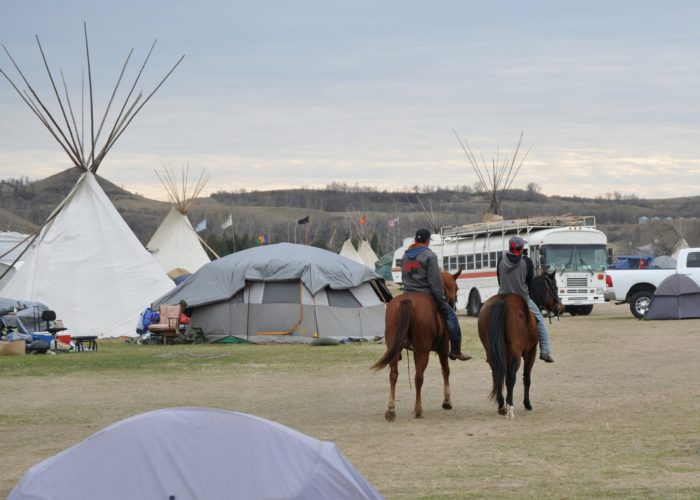
Stephanie Masterman’s trek to join the Standing Rock Sioux to protest the Dakota Access Pipeline began with a canoe journey.
Masterman, 21, is a native Tlingit who joined her tribe’s traditional coastal journey, a coming-of-age trip that usually takes place with other tribes in the waters of the Pacific Northwest, British Columbia and Alaska.
But this year she and a group of other native women living in Seattle decided to make that journey along the Missouri River to the Standing Rock camp in North Dakota.
Masterman and other Pacific Northwest youth have joined hundreds of others from around the country in the growing protest against the Dakota Access Pipeline, which came to a head Sunday night when police attacked protestors with water hoses and tear gas.
The oil pipeline project is on federally owned land, but the Standing Rock Sioux tribe fears the pipeline threatens the drinking water supply and the tribe’s burial and sacred grounds.
The pipeline protests have gained national attention, bringing Native and non-Native activists from around the country together at the camp in North Dakota.
“For everybody to come together like that and work harmoniously, this is huge. This hasn’t happened anytime in history.”
“This is so unheard of for all these tribes to come together,” said Dianne Baumann, a University of Washington graduate student and descendent of the Blackfeet Nation. She also went to North Dakota earlier this year to help.
“People think of Native Americans and they think ‘an Indian is an Indian’, but in the United States there are hundreds of federally recognized tribes and they’re all different,” Baumann said. “And so for everybody to come together like that and work harmoniously, this is huge. This hasn’t happened anytime in history.”
And youth there have led much of the action taken against the pipeline, including runs from the camp to Washington, D.C. to gather more political support — and more direct actions.
“The youth were 100 percent the leaders of those runs,” said Matt Remle, a Seattle-based Native activist who was raised at Standing Rock. “Even in direct actions since then, it’s mostly younger people. They’re chaining themselves to the equipment.”
Masterman, a Seattle resident spent, several weeks at the camp and noted how she felt at home being with other women like her. The journey wasn’t easy. A storm that passed over their course and ripped their camp apart, causing the group to lose many supplies. But upon their arrival, they learned that a severe rain storm had struck a pipeline dig site and had delayed its progress for three days.
The good tidings didn’t stop there.
Masterman said the Standing Rock camp was welcoming. With traditional ceremonies going on from dawn to dusk, a strong connection was shared throughout the camp.
“The spiritual energy around that camp can take you to a whole other world,” Masterman said. “It was so crazy and powerful everyday. I came back a much more spiritually-strong person.”

But the struggle against the pipeline is constant.
Masterman said police have been displacing or arresting campers, meaning more progress for the pipeline. She criticized national media, including CNN, as only depicting the protesters in a negative light. The national media hasn’t shown, for example, detained protesters being put into dog kennels or the killing of animals that happen in the process.
Masterman also criticized President Barack Obama’s lack of a stance on the issue during the election.
“Each day he waits while supporting Hillary (Clinton), they destroy ceremonial burial sites and other indigenous sites. Even in death, everything still has a spirit,” Masterman said. “Time is ticking. People are being displaced, hurt, and they’re being beat, arrested, and thrown in jails. They’re literally dehumanizing people, and by ‘they,’ I mean the police.”
Solomon Rector, 15, accompanied his mother, Tracy Rector, a Native rights activist and filmmaker, to North Dakota to bring supplies to the protesters and to see the standoff firsthand.
Solomon’s mother gave him his first camera days before they departed on October 9th.
“As a mom, I think it’s important to role model priorities and take care of the environment.”
“I was prepared to document with my eyes and bring something back, but bringing a camera is another way to document it from a different perspective,” Solomon said. “It’s vitally important to capture it in every way possible, in other mediums. I’m going there ready to capture what needs to be shown.”
Tracy Rector feels that it’s important for her to model what she considers responsible citizenship for her son. She wants him to know what it takes to really be invested in a cause.
“As a mom, I think it’s important to role model priorities and take care of the environment,” Tracy Rector said. “I’m willing to walk my talk and stand in solidarity, not just be a part of a movement theoretically, but to be present. It’s an important lesson for youth to stand up for the environment.”
Political intervention may be the only chance to stop the pipeline. The U.S. Court of Appeals recently denied an injunction to halt construction.
“Obama has had the power to stop the pipeline all along and we’re disappointed when he said he would wait how it played out over the next few weeks,” Remle said. “We don’t have a few weeks. They’re right at the banks of the Missouri River now.”
Baumann hopes Obama takes action before president-elect Donald Trump takes over.
“He’s got nothing to lose at this point,” Baumann said. “He has the power to shut this down. He can stop this pipeline. He needs to go out with a bang instead of a whisper.”

